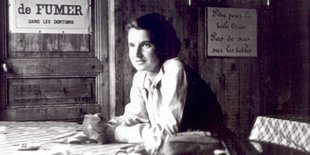Rosalind Franklin - why she will inspire us forever

Scientist and expert crystallographer Rosalind Franklin
Rosalind Franklin made incredible scientific breakthroughs, breaking down barriers for women before she died of ovarian cancer at just 37. Just like ovarian cancer, she can't be overlooked.
Rosalind Franklin was a talented scientist and expert crystallographer whose work led to the discovery of DNA. In 1952, Franklin and her PhD student Raymond Gosling captured ‘Photograph 51’ – arguably now the most famous X-ray in the world, as it revealed the double helix structure of DNA for the first time.
Without her knowledge or consent, Franklin’s colleague Maurice Wilkins showed her X-ray to competing scientists Francis Crick and James Watson. Their jaws dropped as the image provided a vital clue to the structure of DNA. The pair went on to publish their discovery of DNA in Nature Magazine and were later awarded a Nobel Prize. Unlike her two male peers, Franklin was never acknowledged for her contribution to the discovery.
Rosalind Franklin died of ovarian cancer at just 37. It is said that her death disqualified her from winning a Nobel Prize too as they are only given to those who can collect them.
Having ovarian cancer at such a young age can be linked to hereditary risk, and being of Ashkenazi Jewish heritage, Franklin may have carried a BRCA gene mutation that increased her risk of ovarian cancer. It is with her early contribution to discovering DNA that we can perform genetic testing today, and BRCA-positive women can significantly reduce their cancer risk through surveillance and risk-reducing surgeries.
Since Franklin’s death, there has been a growing recognition for her research into the molecular structure of coal, viruses and of course, DNA but lots of people still don’t know who she was. She embodies our commitment that women don't just deserve better, they deserve the best. As arguably the best in her field, who knows what more Rosalind could have achieved.
Over the past few years, we've aimed to ensure nobody forgets Rosalind Franklin's impact and how she is a pioneer in scientific discovery; the discovery that inspires us to do the best for women, funding Europe's first-ever dedicated research centre to drive breakthroughs in ovarian cancer diagnosis and treatment.
In 2018, we teamed with Ovacome, Target Ovarian Cancer, and The Eve Appeal to encourage The Bank of England to make Rosalind the face of Britain's £50 note. Unfortunately, she was overlooked again.
But in 2019, renowned Astronaut Tim Peake revealed that the new UK-made rover headed for Mars will bear the name of British scientist Rosalind Franklin, following a public call that received almost 36,000 responses. Unfortunately, the project has been delayed, but when the rover eventually reaches the Red Planet, equipped with “next-generation instruments”, the six-wheeled vehicle will roam the planet’s surface in search of past and present life. As a talented scientist and expert crystallographer whose work led to the discovery of DNA – a chemical containing, within its double-helix structure, all the information a living organism needs to grow and flourish – it’s, therefore, no wonder that the new rover is named in honour of the woman who gave us the key to understand life here on Earth.
The significance of her work is now widely acknowledged. So on her birthday, we're reminded of why we need to make faster progress in scientific research to make ovarian cancer a survivable disease. We won't give up, Rosalind.
Find out more about the discoveries we're making with the research you help fund